Sustainable Spatial Distribution and Determinants of Key Rural Tourism Villages in China: Promoting Balanced Regional Development
Abstract
:1. Introduction
2. Materials and Methods
2.1. Data Sources
2.2. Research Methods
2.2.1. GIS Spatial Analysis
2.2.2. Dominance Analysis
2.2.3. Geodetector
3. Results
3.1. Spatial Distribution Characteristics of Key Rural Tourism Villages
3.2. Advantage Degree Analysis of Key Rural Tourism Villages
3.3. Analysis of Influencing Factors of Key Villages of Rural Tourism
4. Discussion
5. Conclusions
Author Contributions
Funding
Data Availability Statement
Conflicts of Interest
References
- An, W.; Alarcón, S. How can rural tourism be sustainable? A systematic review. Sustainability 2020, 12, 7758. [Google Scholar] [CrossRef]
- Wijijayanti, T.; Agustina, Y.; Winarno, A.; Istanti, L.N.; Dharma, B.A. Rural tourism: A local economic development. Australas. Account. Bus. Financ. J. 2020, 14, 5–13. [Google Scholar] [CrossRef]
- Liu, C.; Dou, X.; Li, J.; Cai, L.A. Analyzing government role in rural tourism development: An empirical investigation from China. J. Rural Stud. 2020, 79, 177–188. [Google Scholar] [CrossRef]
- Kumar, S.; Valeri, M. Understanding the relationship among factors influencing rural tourism: A hierarchical approach. J. Organ. Change Manag. 2022, 35, 385–407. [Google Scholar] [CrossRef]
- Adawiyah, W.R.; Praptapa, A.; Kusuma, P.D.I.; Sholikhah, Z. Promoting Local Potential as a Strategy to Develop Tourism Village. Geo J. Tour. Geosites 2020, 31, 1113–1118. [Google Scholar]
- Dai, M.L.; Fan, D.X.; Wang, R.; Ou, Y.H.; Ma, X.L. Does rural tourism revitalize the countryside? An exploration of the spatial reconstruction through the lens of cultural connotations of rurality. J. Destin. Mark. Manag. 2023, 29, 100801. [Google Scholar] [CrossRef]
- Wang, X.; Li, X. Spatial characteristics and influencing factors of key rural tourism villages in China. Acta Geogr. Sin. 2022, 77, 900–917. (In Chinese) [Google Scholar]
- Lane, B. What is rural tourism? J. Sustain. Tour. 1994, 2, 7–21. [Google Scholar] [CrossRef]
- Butler, R.W. The concept of a tourist area cycle of evolution: Implications for management of resources. Can. Geogr. 1980, 24, 5–12. [Google Scholar] [CrossRef]
- Zhang, A.; Yang, Y.; Chen, T.; Liu, J.; Hu, Y. Exploration of spatial differentiation patterns and related influencing factors for National Key Villages for rural tourism in China in the context of a rural revitalization strategy, using GIS-based overlay analysis. Arab. J. Geosci. 2021, 14, 1–15. [Google Scholar] [CrossRef]
- Cheng, H.; Yang, Z.; Liu, S.J. Rural stay: A new type of rural tourism in China. J. Travel Tour. Mark. 2020, 37, 711–726. [Google Scholar] [CrossRef]
- Rosalina, P.D.; Dupre, K.; Wang, Y. Rural tourism: A systematic literature review on definitions and challenges. J. Hosp. Tour. Manag. 2021, 47, 134–149. [Google Scholar] [CrossRef]
- Liao, C.; Zuo, Y.; Law, R.; Wang, Y.; Zhang, M. Spatial differentiation, influencing factors, and development paths of rural tourism resources in Guangdong Province. Land 2022, 11, 2046. [Google Scholar] [CrossRef]
- Truden, C.; Kollingbaum, M.J.; Reiter, C.; Schasché, S.E. A GIS-based analysis of reachability aspects in rural public transportation. Case Stud. Transp. Policy 2022, 10, 1827–1840. [Google Scholar] [CrossRef]
- Liu, J.; Zhou, Y.; Gao, H.; Liu, Y. Research on the comprehensive development advantages and coordination of rural tourism: A case study of key rural tourism villages in Central China. Res. Agric. Mod. 2024, 45, 282–295. (In Chinese) [Google Scholar]
- Guo, L.; Li, P.; Zhang, J.; Xiao, X.; Peng, H. Do socio-economic factors matter? A comprehensive evaluation of tourism eco-efficiency determinants in China based on the Geographical Detector Model. J. Environ. Manag. 2022, 320, 115812. [Google Scholar] [CrossRef]
- Madanaguli, A.; Kaur, P.; Mazzoleni, A.; Dhir, A. The innovation ecosystem in rural tourism and hospitality—A systematic review of innovation in rural tourism. J. Knowl. Manag. 2022, 26, 1732–1762. [Google Scholar] [CrossRef]
- López-Sanz, J.M.; Penelas-Leguía, A.; Gutiérrez-Rodríguez, P.; Cuesta-Valiño, P. Sustainable development and consumer behavior in rural tourism—The importance of image and loyalty for host communities. Sustainability 2021, 13, 4763. [Google Scholar] [CrossRef]
- Hassan, T.H.; Salem, A.E.; Abdelmoaty, M.A. Impact of rural tourism development on residents’ satisfaction with the local environment, socio-economy and quality of life in Al-Ahsa Region, Saudi Arabia. Int. J. Environ. Res. Public Health 2022, 19, 4410. [Google Scholar] [CrossRef]
- Chen, J.; Huang, Y.; Wu, E.Q.; Ip, R.; Wang, K. How does rural tourism experience affect green consumption in terms of memorable rural-based tourism experiences, connectedness to nature and environmental awareness? J. Hosp. Tour. Manag. 2023, 54, 166–177. [Google Scholar] [CrossRef]
- Mwesiumo, D.; Halfdanarson, J.; Shlopak, M. Navigating the early stages of a large sustainability-oriented rural tourism development project: Lessons from Træna, Norway. Tour. Manag. 2022, 89, 104456. [Google Scholar] [CrossRef]
- Rocca, L.H.D.; Zielinski, S. Community-based tourism, social capital, and governance of post-conflict rural tourism destinations: The case of Minca, Sierra Nevada de Santa Marta, Colombia. Tour. Manag. Perspect. 2022, 43, 100985. [Google Scholar] [CrossRef]
- Singhania, O.; Swain, S.K.; George, B. Interdependence and complementarity between rural development and rural tourism: A bibliometric analysis. Rural Soc. 2022, 31, 15–32. [Google Scholar] [CrossRef]
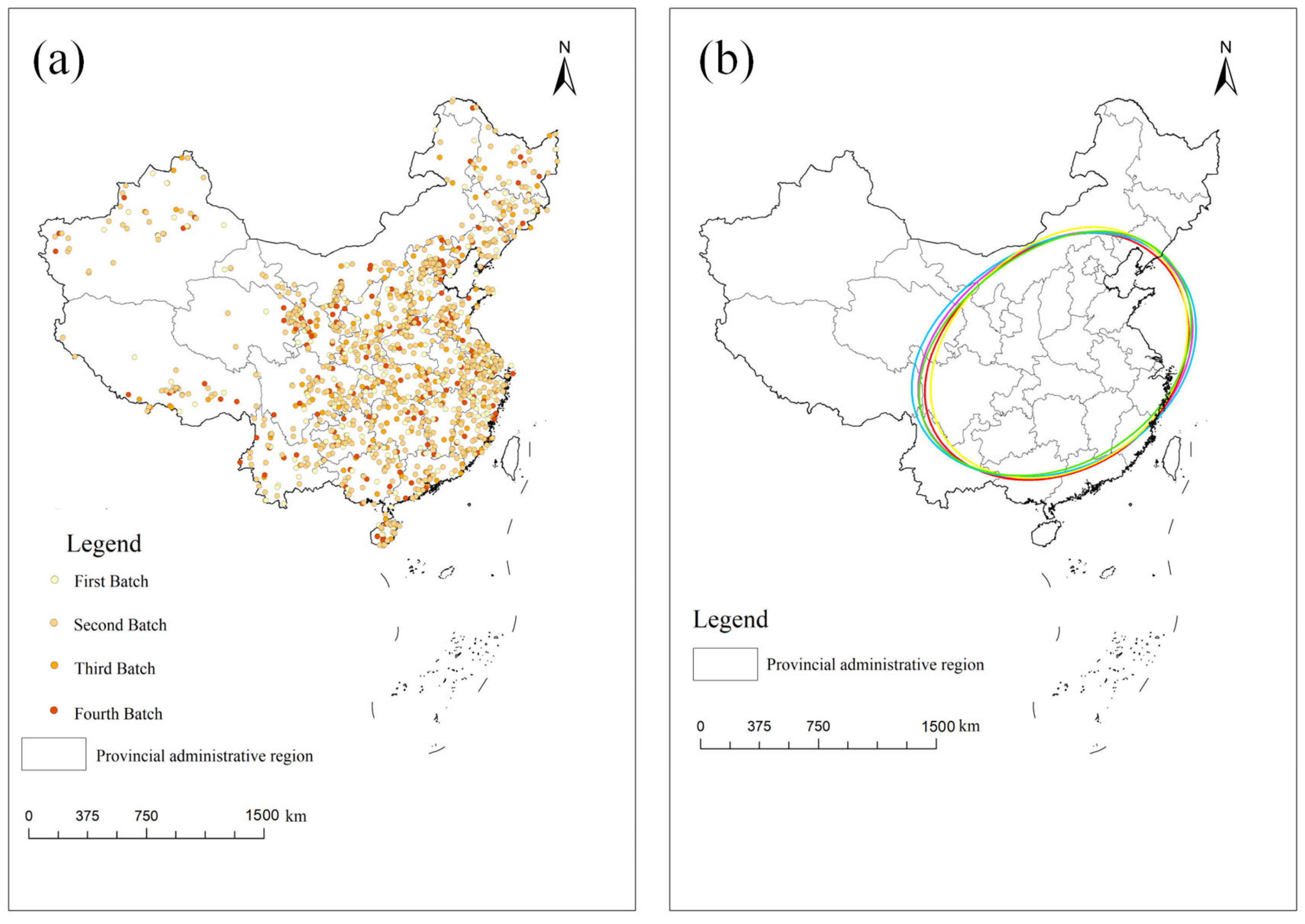
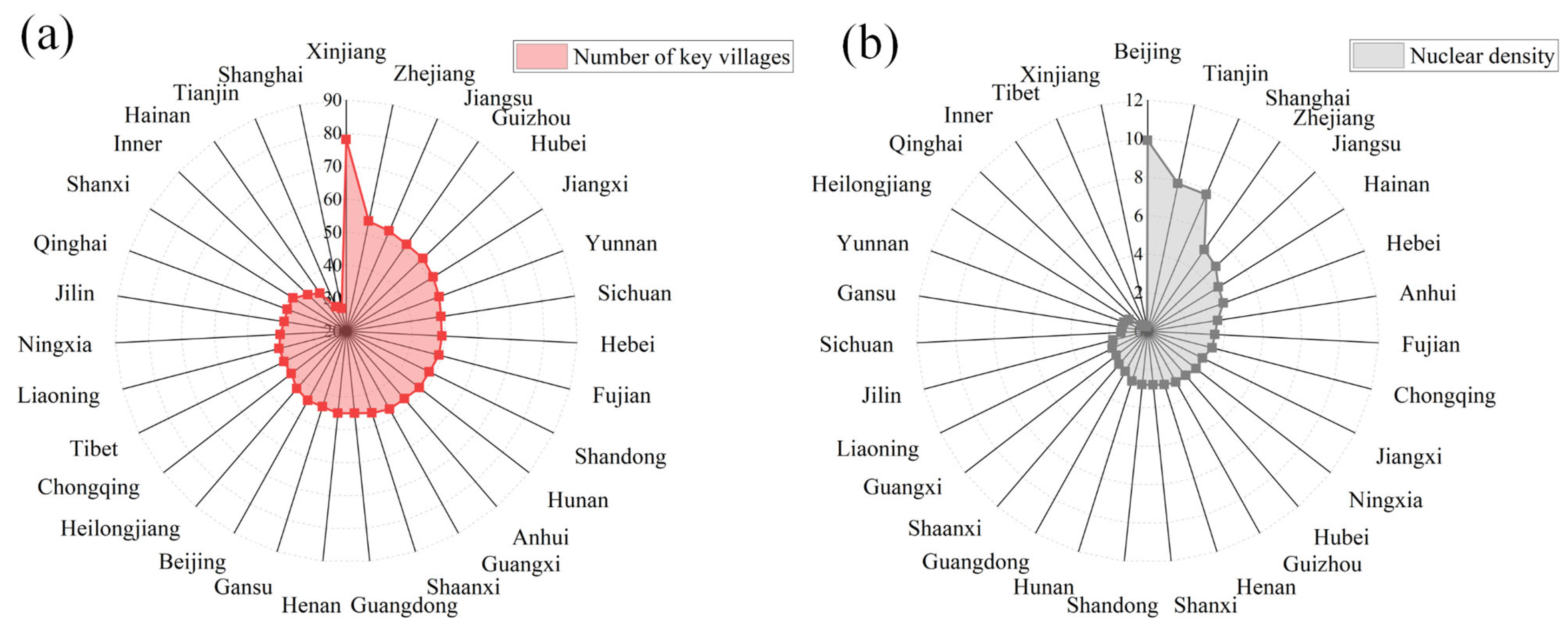
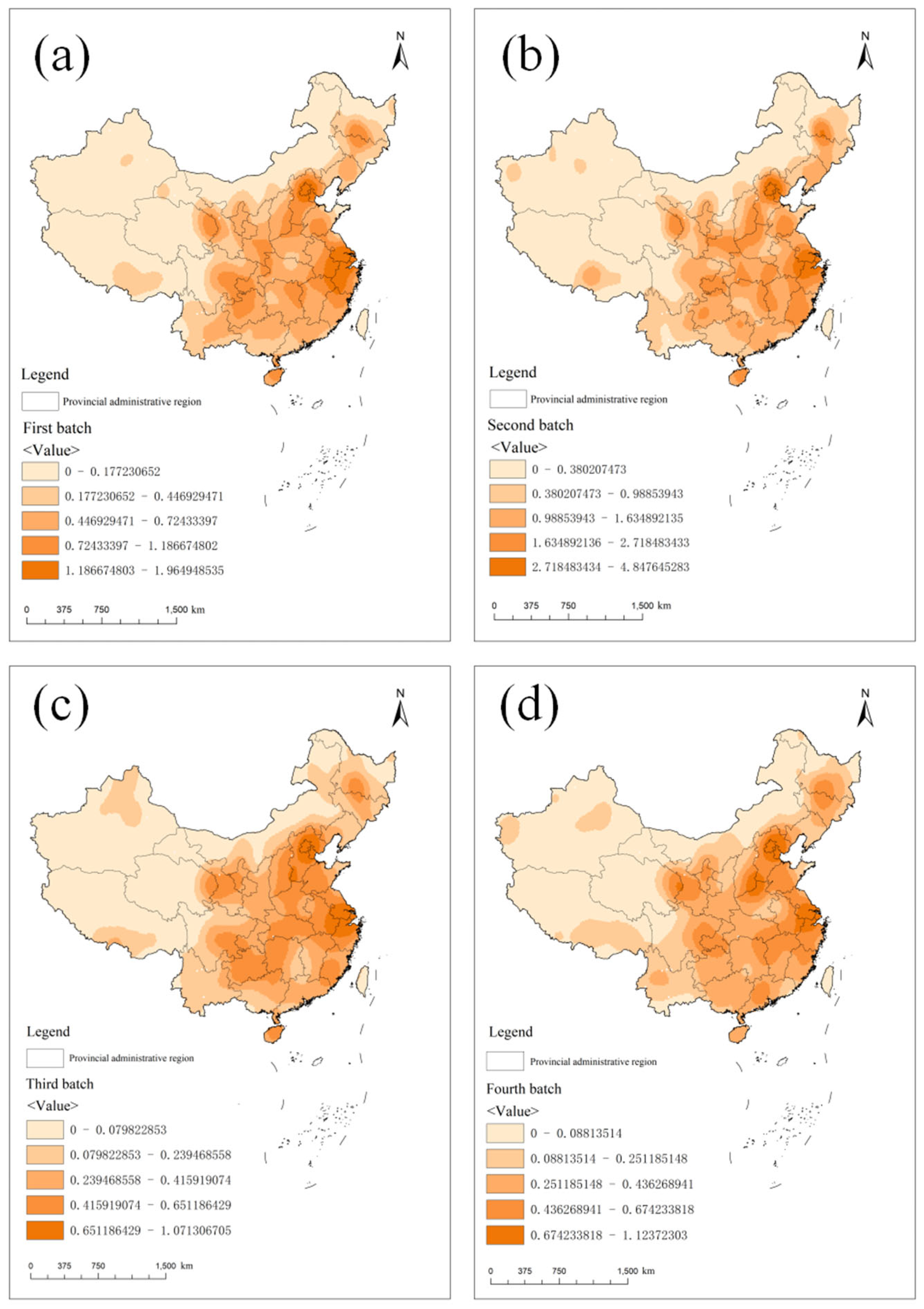
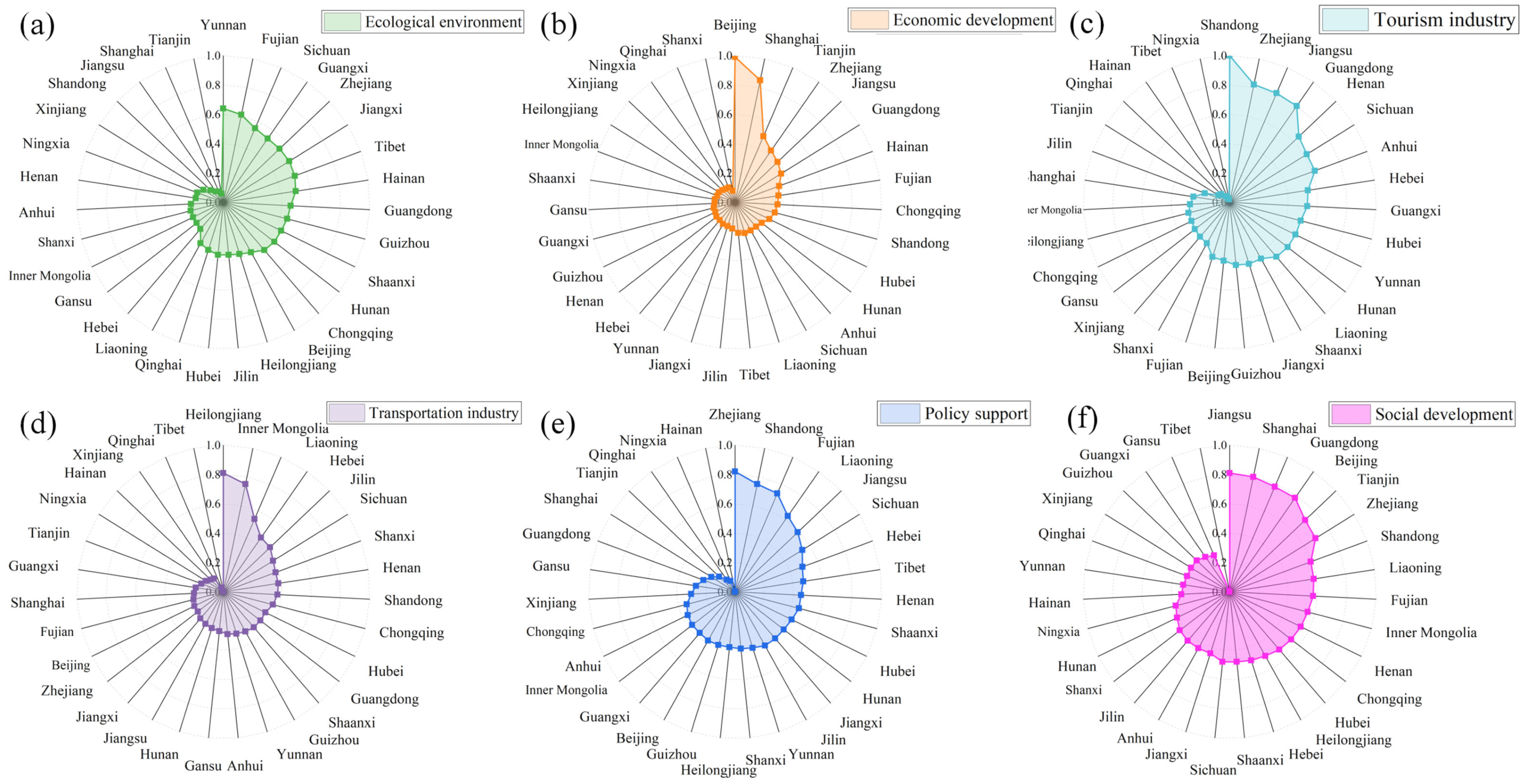
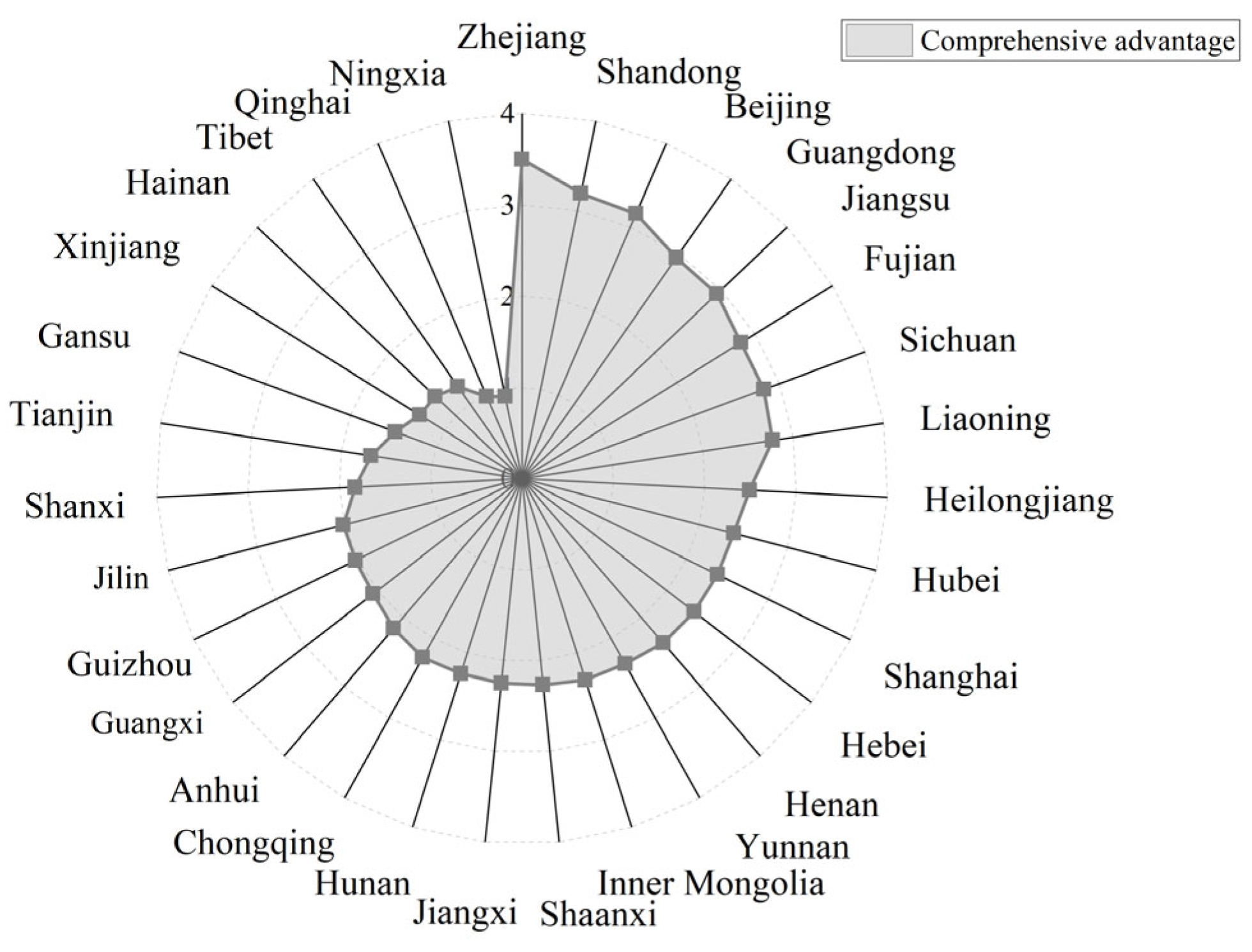
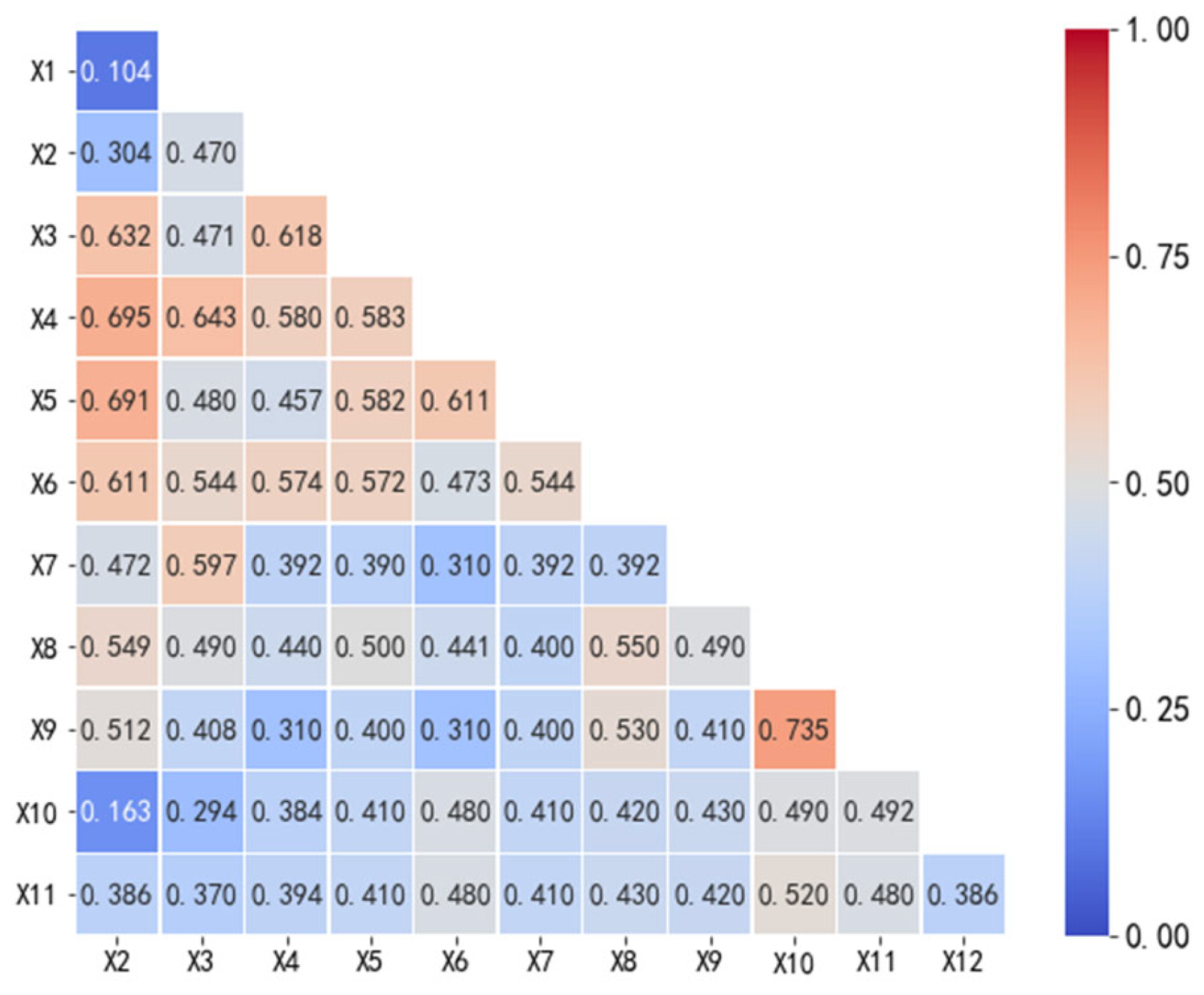
| Batch | East Region Quantity | Central Region Quantity | West Region Quantity | Total |
|---|---|---|---|---|
| First | 126 | 64 | 130 | 320 |
| Second | 270 | 136 | 274 | 680 |
| Third | 79 | 42 | 78 | 199 |
| Fourth | 79 | 40 | 81 | 200 |
| Category | Variable | Indicator Code | Unit/Description | Q Statistic | Normalized Weight |
|---|---|---|---|---|---|
| Ecological Environment | Forest Coverage Rate | X1 | % | 0.273998 | 0.54151 |
| PM2.5 Concentration | X2 | µg/m3 | 0.036298 | 0.07179 | |
| Terrain Ruggedness Index | X3 | ° | 0.192997 | 0.3867 | |
| Economic Development | GDP | X4 | Yuan per person | 0.252739 | 0.2782 |
| Tertiary Industry as a Percentage of GDP | X5 | % | 0.510975 | 0.56274 | |
| Per Capita Disposable Income of All Residents | X6 | Yuan | 0.181703 | 0.15806 | |
| Tourism Industry | Number of Star-Rated Hotels | X7 | items | 0.264158 | 0.22964 |
| Number of A-Level Tourist Attractions | X8 | items | 0.47759 | 0.41523 | |
| Local Employees | X9 | items | 0.280197 | 0.24358 | |
| Number of Travel Agencies | X10 | items | 0.139568 | 0.12128 | |
| Total Number of Tourists Received | X11 | 10,000 | 0.212733 | 0.18528 | |
| Transportation Facilities | Transportation Network Density | X12 | km/km2 | 0.110071 | 0.21289 |
| Train Stations | X13 | items | 0.407028 | 0.78711 | |
| Policy Support | Number of Beautiful Leisure Villages in China | X14 | items | 0.151152 | 0.21074 |
| Number of Demonstration Counties (Points) for Leisure Agriculture and Rural Tourism | X15 | items | 0.383066 | 0.53371 | |
| Number of Traditional Villages | X16 | items | 0.180915 | 0.25555 | |
| Social Development | Urbanization Rate | X17 | % | 0.355609 | 0.67459 |
| Number of Public Toilets | X18 | items | 0.171819 | 0.32541 |
Disclaimer/Publisher’s Note: The statements, opinions and data contained in all publications are solely those of the individual author(s) and contributor(s) and not of MDPI and/or the editor(s). MDPI and/or the editor(s) disclaim responsibility for any injury to people or property resulting from any ideas, methods, instructions or products referred to in the content. |
© 2024 by the authors. Licensee MDPI, Basel, Switzerland. This article is an open access article distributed under the terms and conditions of the Creative Commons Attribution (CC BY) license (https://creativecommons.org/licenses/by/4.0/).
Share and Cite
Gao, Y.; Zhang, H.; Shi, X. Sustainable Spatial Distribution and Determinants of Key Rural Tourism Villages in China: Promoting Balanced Regional Development. Sustainability 2024, 16, 8572. https://doi.org/10.3390/su16198572
Gao Y, Zhang H, Shi X. Sustainable Spatial Distribution and Determinants of Key Rural Tourism Villages in China: Promoting Balanced Regional Development. Sustainability. 2024; 16(19):8572. https://doi.org/10.3390/su16198572
Chicago/Turabian StyleGao, Yanning, Haozhe Zhang, and Xiaowen Shi. 2024. "Sustainable Spatial Distribution and Determinants of Key Rural Tourism Villages in China: Promoting Balanced Regional Development" Sustainability 16, no. 19: 8572. https://doi.org/10.3390/su16198572







